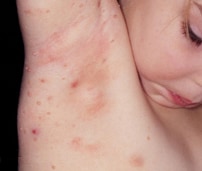Key points
- Molluscum contagiosum is an infection that causes small, raised sores on your body.
- Molluscum spreads from person-to-person contact and through contaminated objects.
- Molluscum is not a serious illness, and children with molluscum shouldn't be kept home from daycare or school.
- At the pool, the virus is likely passed on from objects rather than in the water itself.
- Cover molluscum lesions to keep them from spreading.

Overview
Molluscum contagiosum is an infection caused by a poxvirus that causes small, raised, white, pink, or flesh-colored (growths) that can appear on the body
You can get molluscum if you touch the lesions of someone who has it. It can also spread when you touch items that have the virus on it.
Where molluscum contagiosum spreads
Anyone can get infected, but molluscum is most common in children between 1 and 10 years old. This means that many kids in daycare centers and schools may get it.
Some investigations report that spread of molluscum contagiosum happens in swimming pools. However, it's never been proven how this might happen. It's more likely that activities related to swimming are the cause. For example, the virus might spread from one person to another if they share a towel, kickboard, goggles, or toys.
Prevention steps and strategies
Cover lesions
Covering lesions will help protect others from getting molluscum. This also keeps the child from touching and scratching the lesions, which could spread the infection to other parts of the body or cause bacterial infections.
Cover lesions not covered by clothing with a bandage. Change the bandage when obviously dirty.
If a child with lesions in the underwear/diaper area needs assistance going to the bathroom or needs diaper changes, then lesions in this area should be bandaged too if possible.
When swimming
If a person with molluscum is going swimming, they should:
- Cover all visible lesions with watertight bandages
- Dispose of all used bandages at home
- Not share towels, kickboards, other equipment, or toys
Considerations for pool administrators
Public pool administrators should carefully consider whether or not to keep kids with molluscum out of public pools. Children may need the pool for exercise, social outings, or during camp. Excluding children with molluscum, which is typically not a dangerous infection, could cause embarrassment and create social stigma.
If a public pool does implement a no-molluscum policy, the diagnosis of molluscum contagiosum should be made by a healthcare provider. All participating children should be subject to the same screening physical exam, which would include a thorough skin examination as well.
Disinfect pool equipment
Thorough disinfection and drying of kickboards and other pool equipment that might touch lesions should reduce the likelihood of molluscum contagiosum transmission.
There is no EPA-registered disinfectant approved to kill molluscum contagiosum virus. Household bleach solutions and other EPA-registered surface disinfectants can effectively decontaminate surfaces. Follow the manufacturer's recommendations for concentration, contact time, and care in handling.
- Kakourou T, Zacharides A, Anastasiou T, et al. Molluscum contagiosum in Greek children: a case series. Int J Dermatol 2005;44:221-223.
- Choong KY, Roberts LJ. Molluscum contagiosum, swimming and bathing: a clinical analysis. Australas J Dermatol. 1999;40:89-92.
- Castilla M. Molluscum contagiosum in children and its relationship to attendance at swimming-pools: an epidemiological study. Dermatol. 1995;191:165.
- Niizeki K, Kano O, Kondo Y. An epidemic study of molluscum contagiosum: relationship to swimming. Dermatologica. 1984;169:197-198.
